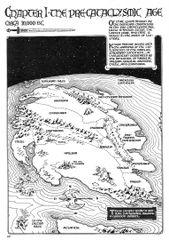It’s 1965 and Beatlemania has swept the world. On TV, Gerry Anderson’s Stingray is chronicling the adventures of Aquanaut, Troy Tempest, and The Thunderbirds are awaiting their signal to ‘GO!’ On the newsstands the pseudo newspaper magazine, TV Century 21, launches, mixing stories of real science with comic strip-style stories of TV shows from both sides of the pond.
Presented here are the first 13 strips of The Daleks, scripted by David Whittaker, but credited to Terry Nation who created them for the Dr. Who TV show. For more info go HERE
Thursday, May 13, 2010
Tuesday, May 11, 2010
Haunted #1: 3 by Ditko
Saturday, April 24, 2010
I Became The Sun Creature (1961) by Bruno Premiani

A story by an unknown writer given a stylish realism by artist Bruno Premiani a few years before he first rendered The Doom Patrol in the same magazine. This story rips a page out of the BBC’s Quatermass dossier, and I could see this as a Hammer movie coming right after 1955’s The Creeping Unknown (The Quatermass Experiment). Atomic surgery, indeed!
NASA's recently launched Solar Dynamics Observatory (SDO) is returning early images that confirm an unprecedented new capability for scientists to better understand our sun’s dynamic processes. These solar activities affect everything on Earth.
Some of the images from the spacecraft show never-before-seen detail of material streaming outward and away from sunspots (see video). Others show extreme close-ups of activity on the sun’s surface. The spacecraft also has made the first high-resolution measurements of solar flares in a broad range of extreme ultraviolet wavelengths.
Launched on Feb. 11, 2010, SDO is the most advanced spacecraft ever designed to study the sun. During its five-year mission, it will examine the sun's magnetic field and also provide a better understanding of the role the sun plays in Earth's atmospheric chemistry and climate. link



My Greatest Adventure #52 (Feb. 1961) © DC Comics
Cover by Dick Dillin (pencils) & Sheldon Moldoff (inks); Art by Bruno Premiani

AIA caught this beautiful prominence eruption only a few days after its doors were opened.
“... and when the planet hit the sun I saw the face of Allison.” (Mose Allsion, that is)
Monday, April 19, 2010
Friday, April 16, 2010
Life on Other Worlds: Callisto (1947) by Murphy Anderson

The well-known Martian meteorite, ALH84001 is unique among Mars rocks available for study on Earth, since its formation age is more than 2.5 billion years older than any other recognized Martian meteorite, giving scientists the only sample of material formed early in Mars' history.
The true age of this meteorite is has now been determined to be 4.091 billion years old, about 400 million years younger than earlier age estimates. This stone formed during an important time when Mars was wet and had a magnetic field, conditions that are favorable for the development of simple life. This finding precludes ALH84001 from being a remnant of primordial Martian crust, as well as confirming that volcanic activity was ongoing in Mars over much of its history.
"This research helps us better refine the history of Mars," Lapen said. "This has huge ramifications for our understanding of volcanic processes active in Mars and for the nature of deeper portions of the planet that are sources of magmas that produced the largest volcanoes in the solar system. These data also are used to refine models of initial planetary formation and early evolution." link
Ref.: A Younger Age for ALH84001 and Its Geochemical Link to Shergottite Sources in Mars. T. J. Lapen, et al. Science 328: 347 - 351.
Abstract: Martian meteorite ALH84001 (ALH) is the oldest known igneous rock from Mars and has been used to constrain its early history. Lutetium-hafnium (Lu-Hf) isotope data for ALH indicate an igneous age of 4.091 ± 0.030 billion years, nearly coeval with an interval of heavy bombardment and cessation of the martian core dynamo and magnetic field. The calculated Lu/Hf and Sm/Nd (samarium/neodymium) ratios of the ALH parental magma source indicate that it must have undergone extensive igneous processing associated with the crystallization of a deep magma ocean. This same mantle source region also produced the shergottite magmas (dated 150 to 570 million years ago), possibly indicating uniform igneous processes in Mars for nearly 4 billion years.
Syd Barrett & Astronomy Domine
Subscribe to:
Comments (Atom)






















































